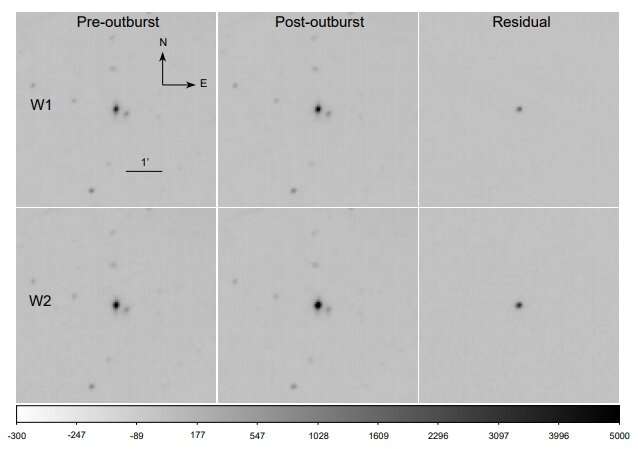June 30, 2020 report
Mid-infrared flare detected in a nearby active galaxy

Chinese astronomers have reported the discovery of a mid-infrared flare in a nearby star-forming galaxy known as MCG-02-04-026. The finding is detailed in a paper published June 22 on arXiv.org, in which the authors try to explain what could be responsible for the observed flaring event.
Observations show that many transient events in active galaxies are accompanied by mid-infrared (MIR) flares, generally lasting for several to 10 years. These flares are known to strengthen the mid-infrared radiation of galaxies and while their origin is still debated; one of the most plausible hypotheses is that they come from dust echoes of transient events.
One of the most important instruments for finding hidden transient events via accompanied MIR flares is NASA's Wide-field Infrared Survey Explorer (WISE) spacecraft. A team of astronomers led by Luming Sun of the University of Science and Technology of China, has employed it to conduct a comprehensive search of MIR flares in nearby galaxies.
The observations resulted in the detection of one such flare in MCG-02-04-026—a nearby, dusty star-forming galaxy hosting a partially obscured supermassive black hole. The newfound MIR flare started in the first half of 2014, peaked around the end of 2015, and faded in 2017.
"We report the discovery of a mid-infrared (MIR) flare using WISE data in the center of the nearby Seyfert 1.9 galaxy MCG-02-04-026," the astronomers wrote in the paper.
The position of the flare coincided with the nucleus of MCG-02-04-026 with an accuracy of about 3,300 light years. The researchers observed the flare's mid-infrared color to be generally turning red. No evidence was found for optical or ultraviolet variations corresponding to the MIR flare.
According to the paper, the MIR flare released a total energy (in the range of 2.8–5.3 µm) of about 740 quindecillion erg. The astronomers estimate that the total infrared energy must be higher than this value, and they calculated it to be at a level of approximately 2,000 quindecillion erg/s.
Moreover, WISE data revealed that X-ray net count rate changed by a factor of about 2.4 between two observations taken around the MIR flare. This suggests a variation in the X-ray luminosity of MCG-02-04-026. However it is still unclear if such behavior in the studied galaxy is related to the MIR flare.
The researchers concluded that the results point out to a dust echo of the primary nuclear transient event as the nature of the observed MIR flare.
"With a dust echo model in which radiative transfer is involved, we interpreted the MIR flare as the reradiation of dust heated by UV-optical radiation from a primary nuclear transient event. The model reproduces the MIR data, and also explains the variation of the MIR color. The no detection of optical or UV variation can be explained as the dust obscuration to the galaxy nucleus," the paper reads.
The astronomers noted that the total energy of the assumed primary transient event must be at least 1,000 quindecillion erg, and most of the energy must be released over less than about three years. They suppose that this event could be a tidal disruption event (TDE), a superluminous supernova, or an enhancement of the existing accretion onto the galaxy's supermassive black hole.
More information: A Mid-infrared Flare in the Active Galaxy MCG-02-04-026: Dust Echo of a Nuclear Transient Event, arXiv:2006.11963 [astro-ph.GA] arxiv.org/abs/2006.11963
© 2020 Science X Network



















